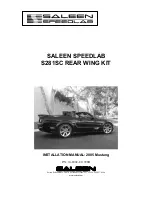
Checking tire pressures manually
To determine and set the correct tire pres-
sure, proceed as follows:
X
Remove the valve cap of the tire that is to
be checked.
X
Press the tire pressure gauge securely onto
the valve.
X
Read the tire pressure and compare it to
the recommended value on the Tire and
Loading Information placard or the tire
pressure table (
Y
page 377).
X
If the tire pressure is too low, increase the
tire pressure to the recommended value.
X
If the tire pressure is too high, release air.
To do so, press down the metal pin in the
valve, using the tip of a pen for example.
Then check the tire pressure again using
the tire pressure checker.
X
Screw the valve cap onto the valve.
X
Repeat these steps for the other tires.
Tire pressure monitor
General notes
If a tire pressure monitor is installed, the vehi-
cle's wheels have sensors that monitor the
tire pressures in all four tires. The tire pres-
sure monitor warns you if the pressure drops
in one or more of the tires. The tire pressure
monitor only functions if the corresponding
sensors are installed in all wheels.
Information on tire pressures is displayed in
the multifunction display. After a few minutes
of driving, the current tire pressure of each
tire is shown in the
Service
menu of the mul-
tifunction display; see illustration (example).
For information on the message display, refer
to the "Checking the tire pressure electroni-
cally" section (
Y
page 383).
Important safety notes
G
WARNING
Each tire, including the spare (if provided),
should be checked at least once every two
weeks when cold and inflated to the pressure
recommended by the vehicle manufacturer
on the Tire and Loading Information placard
on the driver's door B-pillar or the tire pres-
sure label on the inside of the fuel filler flap. If
your vehicle has tires of a different size than
the size indicated on the Tire and Loading
Information placard or, if available, the tire
pressure label, you should determine the
proper tire pressure for those tires.
As an added safety feature, your vehicle has
been equipped with a tire pressure monitoring
system (TPMS) that illuminates a low tire pres-
sure telltale when one or more of your tires
are significantly underinflated. Accordingly,
when the low tire pressure telltale lights up,
you should stop and check your tires as soon
as possible, and inflate them to the proper
pressure. Driving on a significantly underin-
flated tire causes the tire to overheat and can
lead to tire failure.
Underinflation also reduces fuel efficiency
and tire tread life, and may affect the vehicle's
handling and stopping ability. Please note that
the TPMS is not a substitute for proper tire
maintenance, and it is the driver's responsi-
bility to maintain correct tire pressure, even if
Tire pressure
381
Wheels
and
tir
es
Z
Summary of Contents for 2016 GLC
Page 4: ......
Page 32: ...30...
Page 82: ...80...
Page 238: ...236...
Page 306: ...304...
Page 307: ...Useful information 306 Stowage areas 306 Features 318 305 Stowage and features...
Page 325: ...Ensure that you do not pull on the cord Features 323 Stowage and features Z...
Page 338: ...336...
















































